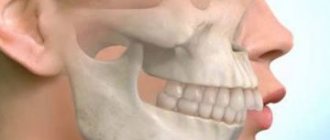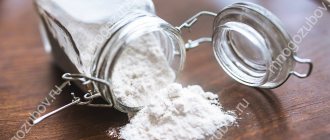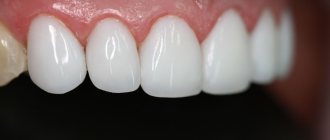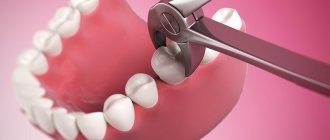Quite often, wisdom teeth cause problems to a person. They erupt at approximately the age of 20-25 years, when the dentition has already formed and in most cases their appearance is accompanied by complications. The extreme molars do not serve any useful function, so dentists often recommend that patients have them removed.
It should be understood that wisdom tooth extraction is a rather complicated procedure for both the doctor and the patient, especially the removal of molars on the lower jaw.
When you need to remove the bottom "eight". Indications
Wisdom teeth are distinguished by late eruption, which occurs at 20-30 years of age. During this period, the dental system is practically formed and the third molars often do not have enough space in the dentition. Eruption causes various complications and in most cases requires removal of the molar. In addition, in humans, with evolution, a decrease in the size of the jaws occurs, since, due to the nature of nutrition, the chewing load is constantly decreasing.
Most people do not take good hygienic care of their last teeth. They are located at the end of the dentition, and it is often technically impossible to clean them well. This leads to the accumulation of plaque, damage to the enamel by the carious process and its complications (pulpitis, periodontitis). Root canal treatment is very difficult due to difficult access. Therefore, eights must be removed in 90% of cases.
Removal of a fully erupted wisdom tooth
Removal of the lower wisdom tooth is indicated in the following cases:
- Excessive pressure on neighboring teeth, which can lead to their destruction;
- Injury to surrounding tissues;
- Constant biting of the mucous membrane of the cheek;
- Carious lesion that cannot be eliminated due to difficult access;
- Complications of caries: pulpitis, periodontitis, periostitis;
- Dystopia – location of the molar outside the dentition;
- A tooth that is a chronic source of infection;
- Formation of perihilar cysts, granulomas;
- Malocclusion and displacement of other teeth.
Destruction of bone structures
The supporting alveolar bone contains a spongy substance that absorbs the chewing load. If at least one tooth is missing, this load changes. Remodeling begins in the bone: its structure, shape, and volume change. In order for it to remain dense and not deform, it needs a constant load that will stimulate it. With edentia, the bone becomes less dense. The alveolar process (or the alveolar part in edentulous lower dentition) becomes narrower. The next stage of destruction is when the bone gradually loses height. Without prosthetics, it decreases by 4 mm in just a year. The width is also reduced - by 25% of the original per year. This process does not stop: if implantation is not performed, destruction will continue. Installing a bridge can only partially solve this problem. This design transmits the chewing load, which is absorbed by the surface layer of bone tissue. The deeper layers remain without constant stimulation. Because of this, blood supply deteriorates and the volume of bone tissue decreases.
When even one tooth is lost, the alveolar bone is rebuilt and resorbed. In place of the hole, a narrow ridge is formed, running along its center. The formation of this ridge complicates prosthetics. When using a removable denture, it rests on the ridge and injures the overlying gum tissue.
Another consequence of bone loss is an increased risk of injury. It especially increases for the lower jaw. With a significant decrease in the volume of bone tissue, there is a possibility of a fracture in this area, even with minor injuries.
It is not only the alveolar bone that suffers from the lack of chewing load. Over time, destruction begins to occur in the main jaw bone. This process occurs faster in the posterior parts of the lower jaw, where destruction of up to 80% of the bone tissue volume is possible in the socket area.
You have questions?
We will call you back within 30 seconds
+7
Bone resorption changes the characteristics of the dental system:
- oblique ridges are formed on the jaw in the sublingual area. May be accompanied by the formation of a local bedsore;
- changing the shape of the chin. In its anterior part there are two tubercles, which can protrude forward during the destruction of bone tissue;
- the muscles are attached near the top of the ridge, which can provoke pain and discomfort;
- thinning of the mucous membrane, causing discomfort even when eating or performing hygiene procedures;
- formation of functional bedsores.
Removal of the lower impacted figure eight
A common complication is wisdom tooth retention, which is incomplete eruption. It can erupt above the gum as part of the crown or as one or two bumps. In this case, the second part of the crown will be covered with a gingival hood. With insufficient hygienic care, food accumulation, gum inflammation, and pericoronitis (inflammation of the hood) occur. In the case of pericoronitis, the dentist excises or cuts the gingival hood. But if the situation is constantly repeated and bothers you, then it is better to remove such a tooth. Chronic inflammation of the gums is a source of infection that spreads throughout the body and can provoke an exacerbation of other diseases.
Why don’t everyone develop eights?
No, not because someone is wise and someone is not so wise. Let's start with the fact that the absence of third molar rudiments from birth is very rare. But not everyone has them. There may be several reasons for this:
- Design features of the jaw . Due to the fact that eights begin to climb at a time when the dentition is already fully completed, they simply have nowhere to squeeze in.
- Genetic predisposition . There is a theory that if you have painful teething or removal of eights in your family, they may not grow.
| According to statistics, 92% of people have all four eights. Of these, in 25% they do not erupt. 8% of humanity does not have third molars even in their embryonic state. And 0.1% of the adult population has a superset - more than four “wise” teeth. |
Anesthesia
Before the operation, complete anesthesia of the required area of the jaw is carried out. The most commonly used is local anesthesia, which is carried out using a carpule syringe and an anesthetic. Anesthesia of the lower jaw occurs 8-10 minutes after the injection. The duration of the analgesic effect depends on the drug used and is 2-4 hours. The operation itself is completely painless, but after the anesthetic wears off, the patient begins to feel pain. Therefore, after the procedure, the specialist gives prescriptions about the need to use medications (painkillers, anti-inflammatory, antimicrobial agents).
Easy removal
Simple extraction is the extraction of a tooth without the use of additional tools or techniques. A simple operation is observed after complete eruption, correct positioning of the molar, and the absence of serious pathologies. The doctor applies forceps and, after rocking movements, removes the molar from the jaw
The following stages of the procedure can be distinguished:
- Anesthesia;
- Selection and preparation of tools;
- Tooth ligament separation;
- Application and fixation of forceps;
- Luxation of a molar;
- Extraction from bone;
- Checking the hole;
- Stop bleeding;
- Recommendations for the patient.
How is the operation performed and how long does it take?
It all starts with an examination and x-ray. The doctor must know how the molar is located and what kind of root system it has. The removal tactics depend on the data received.
Simple extraction
Removing a third molar does not always require complex manipulations. If the crown is well preserved and there are no complications, a simple operation is performed using ordinary forceps. Procedure steps:
- Local anesthesia.
- Antiseptic treatment.
- Application of forceps and their fixation.
- Rocking, dislocation and extraction of the molar from the socket.
- Removing fragments if a tooth is crumbled.
- Treatment of the wound.
Simple extraction lasts from 5 to 15 minutes.
Complex extraction
If the number eight is dystopic, retinal, or all at once, then you won’t be able to get rid of it quickly and easily. To remove the problematic figure eight, the doctor can use a scalpel, drill, laser, elevator and other surgical instruments. Operation stages:
- Local or general anesthesia.
- Antiseptic treatment.
- Dissection of the gum, spreading its edges and exposing the tooth.
- If necessary, drilling or cutting off bone tissue, dividing the tooth root into several parts.
- Complete or partial extraction of a dental unit.
- Stop bleeding.
- Treatment of the wound with antibacterial and anti-inflammatory medications.
- Stitching of soft tissues.
The duration of complex extraction is from 30 minutes to 2 hours. If non-absorbable threads were used to stitch the gums, after 7-10 days you need to contact the clinic to remove them.
| It is easier to remove a wisdom tooth from the upper jaw than from the lower jaw. This is because the root of the upper molars is smooth and small, while the roots of the lower molars are complex and tangled. Plus, the lower jaw is denser and more massive than the upper jaw. |
Difficult removal
Removing a wisdom tooth in the lower jaw is often difficult. The operation differs in its duration, the use of a special instrument, and the use of a drill. Often the tooth is sawed and removed in parts. In this case, the figure eight is incorrectly positioned or impacted. Removal consists of the following steps:
- High-quality pain relief;
- Preparation of tools and auxiliary materials;
- Separating the tooth ligament or creating access;
- Application and fixation of forceps;
- Extraction of a molar in whole or in parts;
- Inspection of the bone socket, cleaning it if necessary;
- Stop bleeding;
- Stitching;
- Prescriptions and recommendations for the patient.
What kind of teeth are these?
Wisdom teeth (also known as third molars) are the eighth units in the upper and lower rows, counting from the middle. Other distinguishing features include:
- absence of a neighboring tooth on the left or right;
- lack of a milk precursor;
- eruption in the jaw bone, which is completing its development.
In fact, eights are a rudiment that we inherited from our ancestors from a primitive society, whose jaws were much more massive. In the course of evolution, people became smarter and mastered the thermal processing of food. The chewing muscles and jaws became smaller and smaller. So the third molars became “unnecessary”.
Possible consequences after removal
Complications can occur after any surgical procedure. These include: bleeding from the wound, suture dehiscence, inflammation of the socket (alveolitis), increased body temperature over 38 degrees, numbness of the jaw, bone fragments or tooth remains in the socket.
A normal reaction of the body in response to surgery is the appearance of pain, discomfort, unpleasant sensations in the surgical area, a slight increase in temperature, swelling of the angle of the jaw, and facial asymmetry. These symptoms occur due to soft tissue injury, damage to blood vessels and nerve endings. The pain should subside over time and disappear after 5-10 days.
If after 3-4 days the pain does not decrease and the symptoms of inflammation increase, you should consult a dentist. The most unpleasant complication is alveolitis - inflammation of the socket of an extracted tooth. It manifests itself as acute pain, redness and swelling of the gum tissue, a significant increase in temperature, and general symptoms. The wound may discharge purulent contents or necrotic plaque. In this case, treatment by a dentist is necessary.
About the removal of premolars (continued, part 2)
When do we most often delete “fours”? Right. When we (or rather teeth) don’t have enough space on the jaw. And the teeth are “in a bunch.” And instead of expanding the “living space” (developing the jaw), we reduce the number of teeth. Thus perpetuating the jaw deformation.
The reason there is not enough space for the teeth is that those six bones of the maxillary complex (palatine, maxillary and incisive) are in compression, in other words, “flattened”, welded to each other. And the stitches on the upper jaw are blocked. No micro-movement. And instead of unblocking the stitches, we remove the teeth. And then what? That's right - we close the gaps from the extracted teeth.
Now pay attention to where the premolars are located relative to the bones of the upper jaw. And what happens when a premolar (usually a “four”) is removed and we try to distalize (move back, inward) the entire frontal group of teeth (incisors and canines)? It only seems to us that by closing the gaps we only move the teeth: first the canines in place of the removed premolars, and then a group of incisors. But in fact, we move, among other things, the incisal bones towards the maxillary bones, thereby exacerbating the block in the sutures between them and “fixing” the deformity. Under the influence of the incisal bones moving inward, the maxillary bones also move inward (towards the palatine bones). And under the influence of the maxillary - palatine. This is how the “tale about the turnip” turns out...
What do the palatine bones come into contact with?
Where (in which direction) are they moving? Right. Towards the sphenoid (in other words, the main ) bone, also causing displacement and compression (compression) in this area. And the sphenoid (main) bone is, for a second, one of the bones of the base of the skull ( w-e-r-e-p-a!!! ). And it is not surprising that after treatment with the removal of premolars, the patient may experience (and very often does) a completely non-dental clinic. But rather neurological. Or even psycho-neurological. Headaches, neck pain, myofascial syndrome, tinnitus, blurred vision, hearing, panic attacks... What do you want? This is a skull. And any ill-considered intervention in its structures is fraught.
I'm not even talking about the deterioration of facial aesthetics: sunken lips, cheeks, protruding cheekbones, concave profile... We in no way associate these manifestations with treatment by an orthodontist. But in fact, they can be a direct or indirect consequence of treatment with the removal of premolars.
Everyone now loves to talk and talk about psychosomatics . About its cause-and-effect relationship with many, many diseases. This is a newfangled interpretation of the old common expression that “all diseases come from nerves.” Well, I can’t say for all diseases (I specialize more in teeth and jaws). But the fact that cranial (cranial) distortions constitute precisely the somatic component of psycho-somatics is a fact. Literally, a medical fact. And by exacerbating these distortions with ill-conceived and unpredictable interference in the anatomy of the skull (especially by removing and moving teeth), are we often aggravating the patient’s ill health? Read the end of the article...
Sign up for diagnostics
Social Like
Comments for the site
Cackl e
Prevention after surgery
After the last molar is removed, the specialist gives instructions that must be strictly adhered to. This is done to prevent complications, speed up wound healing and restore the body. The doctor recommends:
- Do not eat food for several hours after surgery;
- On the first day, you can apply a cold compress to reduce swelling and inflammation;
- For the first two days, you should not rinse your mouth, so as not to remove the blood clot from the hole from which healing will occur;
- Hygienic care can be carried out as usual; teeth in the surgical area should be brushed very carefully;
- Take painkillers and other medications prescribed by your doctor;
- From the second day, the mouth can be rinsed with antiseptic solutions, decoctions of medicinal herbs, and mouth rinse;
- It is recommended to eat soft foods, avoid too hard, spicy, hot foods;
- Bad habits (smoking, drinking alcohol) should be eliminated;
- During the week you cannot visit the sauna, bathhouse, or gym.
How to prepare for the procedure?
Proper preparation includes following a few simple guidelines:
- Do not drink alcoholic beverages 1-2 days before surgery.
- 1-2 days before the intervention, stop taking medications that reduce blood clotting (Aspirin, Ibuprofen, Heparin, etc.).
- On the eve of the operation, do not visit the bathhouse, sauna or solarium.
- One hour before the procedure, eat well.
- Perform all necessary oral hygiene procedures before visiting the clinic.
| To prevent chapped lips, use clear chapstick or Vaseline before visiting the dentist. |
Bleeding
If bloody discharge appears from the socket of an extracted wisdom tooth, you should call your doctor and report the situation. Minor gum bleeding can occur due to tissue injury, high blood pressure, or problems with blood clotting. In most cases, this does not threaten health and goes away on its own. If bleeding is severe or frequently repeated, you should inform your doctor and come for an examination. To prevent complications, you should rest more for several days, avoid physical activity, and monitor your blood pressure.
Pain in the socket
Everyone experiences pain after removal surgery and worries for several days. The intensity of pain will depend on the traumatic nature of the operation and the complexity of the surgical interventions. During the postoperative period, the dentist recommends using painkillers. If the pain does not disappear, but intensifies after 3-4 days, this may indicate complications. A professional examination and consultation with a doctor are required.
When should a wisdom tooth in the lower jaw not be removed?
There are no absolute contraindications to removal, but there are relative ones:
- The figure eight does not need to be removed if it is correctly positioned, functions and does not injure surrounding organs;
- The operation cannot be performed without preliminary preparation if the tooth is located in the area of the tumor or puts pressure on a large vessel or nerve;
- For some diseases, it is necessary to prepare the body for surgery (rheumatism, diabetes, blood diseases, etc.)
You can carry out high-quality removal of a wisdom tooth of any complexity at the Berezka dental clinic. Specialists perform various surgical procedures effectively, safely and painlessly. All manipulations are carried out professionally and taking into account the individual characteristics of each patient.
Psychological aspects of tooth loss
Psychological effects range from minimal to neurotic. It gets to the point that people are not able to wear dentures at all, and thinking that they will have to communicate with someone, they do not leave the house at all.
- Fear of an awkward situation if the prosthesis accidentally detaches.
- Losing teeth affects relationships with the opposite sex
- The occlusal (chewing) load is reduced, and the patient cannot afford to eat all the food he would like.
- Inability to eat in public.
- Speech problems. Diction problems in patients can be very serious.











